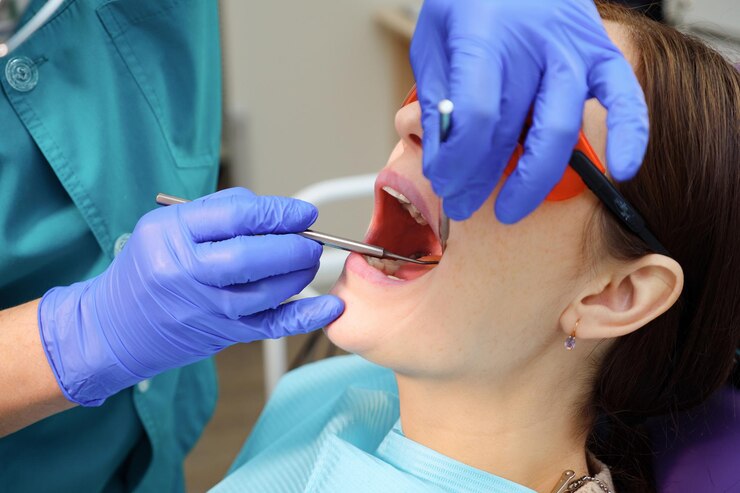Gum disease, also known as periodontal disease, is a common yet often overlooked condition that affects the gums and surrounding structures of the teeth. It begins with the accumulation of plaque—a sticky film of bacteria—on the teeth, which can lead to inflammation of the gums. As the disease progresses, it can cause significant damage and, in severe cases, lead to tooth loss.
Understanding the causes, symptoms, and treatment options for gum disease is essential for maintaining oral health.
Causes of Gum Disease
Gum disease primarily arises from poor oral hygiene practices that allow plaque to form on the teeth and harden into tartar. The bacteria in plaque release toxins that irritate the gum tissue, causing inflammation known as gingivitis. While gingivitis can be reversed with good dental hygiene, untreated gingivitis can progress to periodontitis, a more severe form of gum disease. Factors contributing to gum disease include smoking, hormonal changes (such as those occurring during pregnancy or menopause), certain medical conditions (like diabetes), and medications that reduce saliva flow, making it difficult for the mouth to wash away food particles and plaque.
Additionally, genetics plays a role; some individuals may be more predisposed to gum disease based on their family history. Poor nutrition, particularly deficiencies in vitamins and minerals, can also compromise the immune system and hinder the body’s ability to fight off infections, including those affecting the gums. Stress, another contributing factor, can negatively impact oral health by fostering habits such as teeth grinding or neglecting oral hygiene, further exacerbating the risk of gum disease.
Symptoms of Gum Disease
Recognizing the symptoms of gum disease is crucial for timely intervention. The early stages, namely gingivitis, often present subtle signs that may go unnoticed. These may include swollen or tender gums that bleed when brushing or flossing. As the disease progresses to periodontitis, symptoms may become more pronounced. Patients may experience persistent bad breath, receding gums that expose more of the tooth surface, and pockets forming between the teeth and gums, which can become infected.
In advanced stages, individuals may notice loose teeth or changes in their bite. Gums may appear puffy or may even change color, becoming a darker shade of red. Such changes not only affect aesthetics but can also lead to more severe health complications if left unaddressed. Regular dental check-ups are essential for diagnosing gum disease early, as many people may not be aware of these symptoms until the condition has escalated.
Treatment Options for Gum Disease
The good news is that gum disease is treatable, especially when caught early. Treatment options vary based on the severity of the condition. For mild cases of gingivitis, professional dental cleanings can effectively remove plaque and tartar buildup. Patients are also encouraged to adopt improved oral hygiene practices at home, including regular brushing, flossing, and using antibacterial mouthwashes.
If the gum disease has progressed to periodontitis, more intensive treatments may be necessary. Scaling and root planing is a common non-surgical procedure wherein dental professionals thoroughly clean the surfaces of the teeth both above and below the gum line. This process removes plaque, tartar, and bacteria, allowing the gums to heal and reattach to the teeth.
In cases where gum disease is particularly severe, surgical interventions may be required. Procedures such as flap surgery (pocket reduction surgery) can help reduce the size of gum pockets and promote better cleaning access. Bone grafting may also be necessary in situations where the bone supporting the teeth has been lost due to gum disease.
Furthermore, effective gum disease treatment often incorporates lifestyle changes. Quitting smoking can significantly improve gum health, as can adopting a nutritious diet rich in vitamins and minerals that strengthen the immune system. Patients may also benefit from stress management techniques, which can help reduce the risk of gum disease-related behaviors.
Preventing Gum Disease
Prevention is undoubtedly the best approach to gum disease. Maintaining excellent oral hygiene is paramount, which includes brushing teeth at least twice a day with fluoride toothpaste, flossing daily, and using mouthwash as directed. Regular dental check-ups—ideally every six months—allow for professional cleanings and early detection of any issues before they escalate into more serious conditions.
Moreover, establishing a good relationship with a dental care provider can offer patients personalized advice and treatment options tailored to their specific needs. For those who may have previously neglected their oral health, consulting with a compassionate and knowledgeable dental team can make a significant difference.
Conclusion
Gum disease is a prevalent condition that can lead to serious oral health issues if not addressed promptly. Understanding its causes, recognizing symptoms, and exploring treatment options are crucial steps in maintaining a healthy smile. If you or a loved one is experiencing symptoms of gum disease or seeking preventative care, consider reaching out to Laguna Niguel Smiles Dentistry.
Their experienced team is dedicated to providing comprehensive dental care tailored to each patient's needs, ensuring that you achieve optimal oral health. Don’t wait—take the first step towards a healthier smile today!





Comments